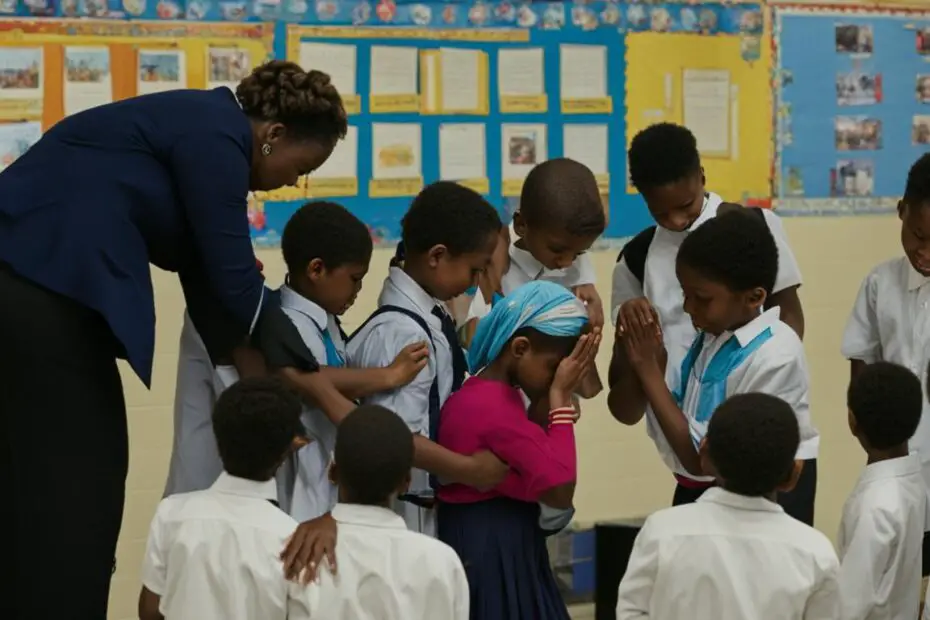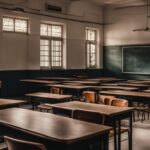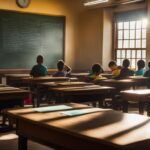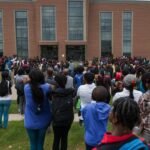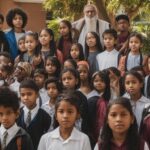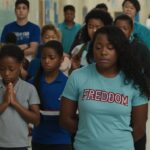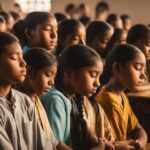Discover the fascinating history of prayer in schools in the United States, a topic that has stirred much debate and controversy over the years. From the separation of church and state to the protection of constitutional rights, this article takes a closer look at the evolution of prayer practices and the role of the Supreme Court in shaping educational policies.
Key Takeaways:
- The Supreme Court has played a significant role in shaping the educational policies and prayer practices in public schools.
- Organized prayer in schools raises concerns related to the entanglement of church and state.
- Teaching about religion in public schools requires a delicate balance to respect the First Amendment’s Establishment Clause.
- The Supreme Court has consistently upheld the ban on school-sponsored prayer while allowing voluntary student-initiated religious activities.
- The Elementary and Secondary Education Act prohibits organized and school-sponsored prayer but protects the right to private and voluntary prayer by students.
Organized Prayer in Schools: Church and State Entanglement
Many people believe that introducing organized prayer in schools can help address social issues such as violence and drug abuse. However, this practice raises concerns regarding the entanglement of church and state in public schools. Public tax dollars fund these institutions, which serve students from diverse religious beliefs and non-believers alike. It is essential to navigate this sensitive territory while upholding the principles outlined in the First Amendment of the United States Constitution.
One significant legal precedent that emphasizes the separation of church and state in public schools is the 2000 U.S. Supreme Court ruling in Santa Fe Independent School District v. Doe. The Court declared that even if prayer activities within schools are student-led, school-sponsored prayer still violates the First Amendment. This ruling reinforces the importance of protecting the rights and beliefs of all students in public schools.
“We have a duty to ensure that public schools remain neutral and inclusive spaces, respecting the diverse religious perspectives of students and preserving the principle of the separation of church and state.”
Addressing Concerns:
The debate surrounding organized prayer in schools stems from the desire to foster a sense of morality and promote positive values among students. However, it is crucial to explore alternative ways to achieve these goals that do not compromise the principles of church-state separation and respect for individual beliefs.
- Encouraging inclusive and ethical education: Public schools can provide comprehensive moral education that embraces universal values such as empathy, respect, and kindness. By incorporating these principles into the curriculum, schools can cultivate a positive and inclusive learning environment.
- Fostering diversity and understanding: Schools play a vital role in fostering an atmosphere of acceptance and understanding among students with different religious backgrounds or no religious affiliation. Emphasizing tolerance and respect for diversity can help create a nurturing environment for all.
- Supporting extracurricular groups: Public schools can support the formation of student-led extracurricular groups that cater to various religious and philosophical beliefs. These groups provide a platform for students to express and explore their faith or lack thereof while respecting the rights and beliefs of others.
The First Amendment and Balancing Rights:
The First Amendment of the United States Constitution protects the rights of both religious and non-religious individuals. It ensures the freedom to practice any religion or no religion at all without government coercion. It is through the application of this fundamental principle that public schools can maintain an unbiased and inclusive environment for all students.
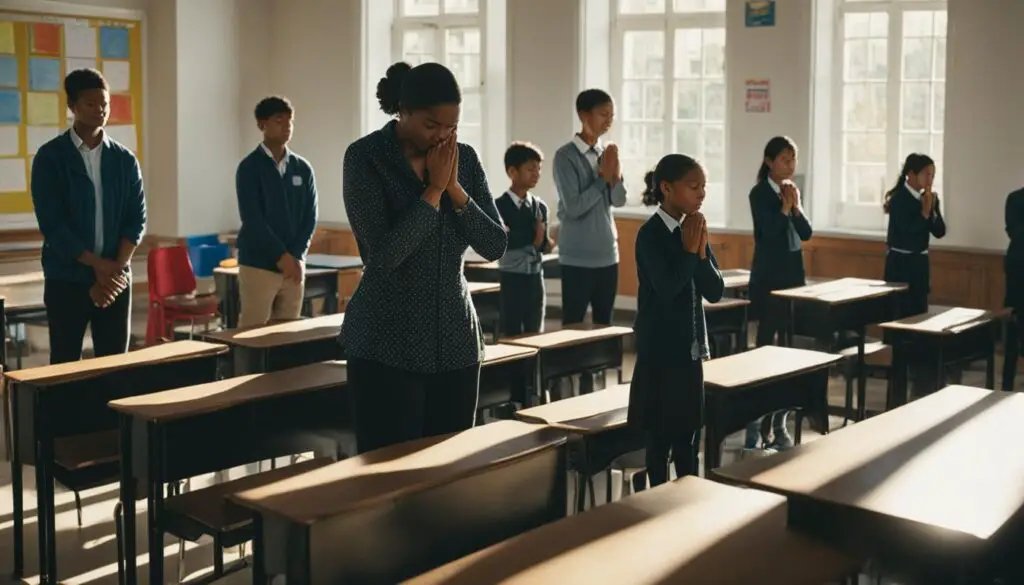
It is crucial to recognize that while organized and school-sponsored prayer is prohibited, private and voluntary prayer by students is constitutionally protected. Public schools have a responsibility to create an atmosphere that respects the rights and beliefs of every individual while promoting a positive and inclusive educational experience for all.
Teaching About Religion in Public Schools: Balancing Act
Teaching about religion in public schools is a complex endeavor that requires a delicate balance. On one hand, it is important to provide students with a comprehensive understanding of different religions, fostering cultural and religious literacy. On the other hand, educators must ensure that their teachings do not violate the Establishment Clause of the First Amendment, which prohibits the government from promoting or endorsing any particular religion.
In the landmark case of Abington v. Schempp, the Supreme Court clarified the parameters for teaching about religion in public schools. The Court ruled that objective, academic instruction about religion is permissible as part of a secular program of education.
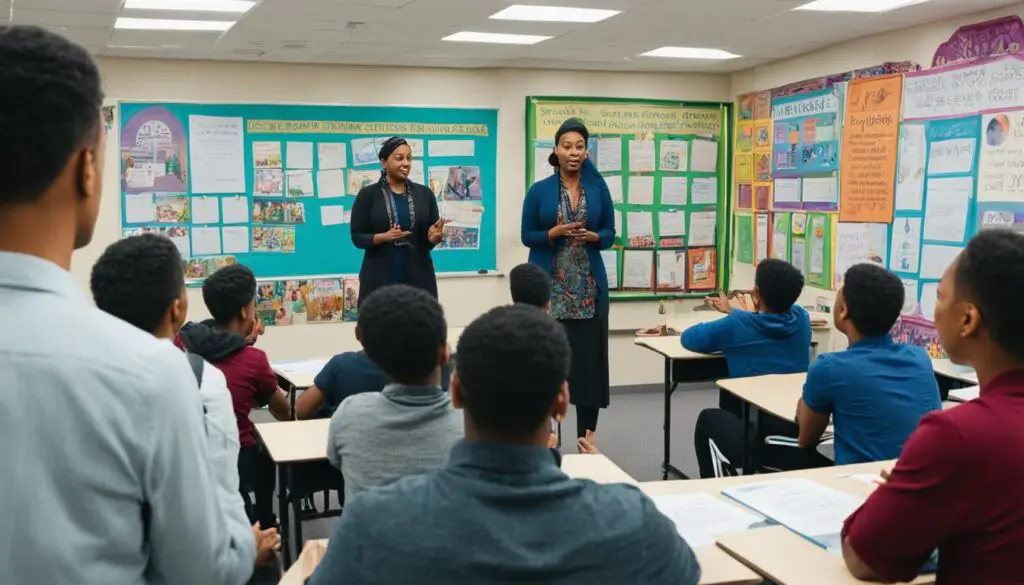
This ruling emphasizes the importance of presenting religious content in an unbiased and educational manner. It allows schools to teach about religion from a historical, cultural, and literary perspective, rather than promoting any specific religious beliefs or practices.
“It might well be said that one’s education is not complete without a study of comparative religion, or the history of religion and its relationship to the advancement of civilization. It certainly may be said that the Bible is worthy of study for its literary and historic qualities.”
– Supreme Court Justice Tom C. Clark, Abington School District v. Schempp (1963)
By offering objective instruction on religion, public schools can foster an environment where students develop tolerance, respect, and a deeper understanding of different faith traditions. It enables students to become well-informed global citizens who can navigate diverse religious perspectives and better appreciate the multifaceted nature of society.
While the teaching of religion in public schools is constitutionally protected, it is crucial for educators to approach the topic with sensitivity and respect for students’ diverse beliefs. By providing a comprehensive education on religion while upholding the principles of the Establishment Clause, public schools can fulfill their role in preparing students for a pluralistic society.
Supreme Court Rulings on School Prayer
The U.S. Supreme Court has played a crucial role in shaping the landscape of school prayer in the United States. Over the years, several landmark rulings have established the boundaries between religious expression and the First Amendment rights in public schools.
In 1962, the landmark case Engel v. Vitale set a precedent by declaring school-sponsored prayer unconstitutional. The Court held that organized prayer endorsed by public schools violates the Establishment Clause of the First Amendment, which prohibits the government from establishing or promoting religion.
“We think that through its positive programs the State of New York has adopted a system of prayers and religious exercises which violates the neutrality required of it by the First and Fourteenth Amendments… By providing the prayer, New York officially declares that those who oppose the legislation and the practices it authorizes, as well as those who refuse to participate in the religious exercises it prescribes, are outsiders, not full members of the political community, and adherents to other beliefs are citizens of a lesser class.”
Since then, the Supreme Court has consistently upheld the ban on school-sponsored worship. The Court has emphasized that public schools must remain neutral in matters of religion to protect students’ rights to freedom of conscience and promote inclusivity.
In the landmark case of Santa Fe Independent School District v. Doe in 2000, the Supreme Court ruled that even student-led, school-sponsored prayers at public school sporting events violate the First Amendment. The Court reasoned that such prayers create an atmosphere of religious endorsement, putting pressure on students to conform and potentially isolating those with different beliefs.
“The delivery of such a message—over the school’s public address system, by a speaker representing the student body, under the supervision of school faculty, and pursuant to a school policy that explicitly and implicitly encourages public prayer—is not properly characterized as ‘private’ speech.”
Through these rulings, the Supreme Court has upheld the principles of religious freedom and ensured that public schools in the United States remain inclusive environments for students of all backgrounds and beliefs.
The Importance of the First Amendment
The First Amendment guarantees the separation of church and state, protecting individuals’ rights to practice their religion freely and prohibiting the government from establishing or endorsing a specific religion. These principles safeguard the diversity of belief systems and ensure that public institutions, including schools, remain neutral and welcoming to all.

Elementary and Secondary Education Act and School Prayer Guidelines
The passage of the Elementary and Secondary Education Act in 2001 brought about new guidelines on school prayer, established by the Department of Education. These guidelines faced criticism for their attempts to address constitutional debates without sufficient community input. However, it is crucial to note that while organized and school-sponsored prayer is prohibited, private and voluntary prayer by students is constitutionally protected.
These guidelines aim to ensure that public schools maintain a neutral stance on matters of religion while respecting the rights of individuals to exercise their faith. By allowing students the freedom to engage in private prayer, the Elementary and Secondary Education Act strikes a balance between safeguarding religious expression and avoiding the endorsement of a particular belief system.
“The guidelines on school prayer, although subject to criticism, serve as an important framework for upholding the principles of religious freedom and separation of church and state. By protecting the rights of students to pray privately, we create an environment that respects diverse beliefs and allows for individual expression.”
Protecting Students’ Constitutional Rights
The Elementary and Secondary Education Act recognizes that public schools play a vital role in nurturing the intellectual and personal development of students. By fostering an inclusive environment that respects the rights and beliefs of all individuals, these guidelines reflect our commitment to upholding the principles enshrined in the First Amendment of the United States Constitution.
The act acknowledges that while educational institutions should not endorse or promote specific religious practices, they should also not hinder an individual’s ability to privately express their faith. By safeguarding the rights of students to engage in voluntary prayer, the act promotes an atmosphere of respect, tolerance, and religious freedom within public schools.
The Importance of Community Input
In the development of the school prayer guidelines, it is vital to acknowledge the significance of community input. Balancing the diverse perspectives and beliefs within society requires thoughtful consideration and engagement with all stakeholders, including parents, educators, religious leaders, and civil liberties advocates.
Community input fosters an inclusive decision-making process that takes into account the values and concerns of the people directly affected by the guidelines. By incorporating a broad range of perspectives, the guidelines can better reflect the needs and aspirations of the diverse communities they serve.
Safeguarding Religious Freedom for All
While the issue of school prayer will continue to spark debates and discussions, it is important to remember that the essence of religious freedom lies in protecting the rights of individuals to practice their faith according to their own beliefs. The Elementary and Secondary Education Act, with its guidelines on school prayer, strikes a delicate balance between these constitutional rights and the need to maintain a secular public education system.
By upholding the principles of religious freedom and respecting the boundaries of the separation of church and state, we can create an educational environment that fosters inclusivity, tolerance, and mutual respect among students of all religious backgrounds and beliefs.
Status of Current Law on Public Posting of the Ten Commandments
The posting of the Ten Commandments in public schools or other public entities has been a contentious issue. In 1980, the Supreme Court struck down a Kentucky law requiring public schools to display the Ten Commandments. In 2005, the Court issued a split decision on public displays of the Ten Commandments, finding that some displays favored monotheistic religions, while others conveyed both religious and secular messages.
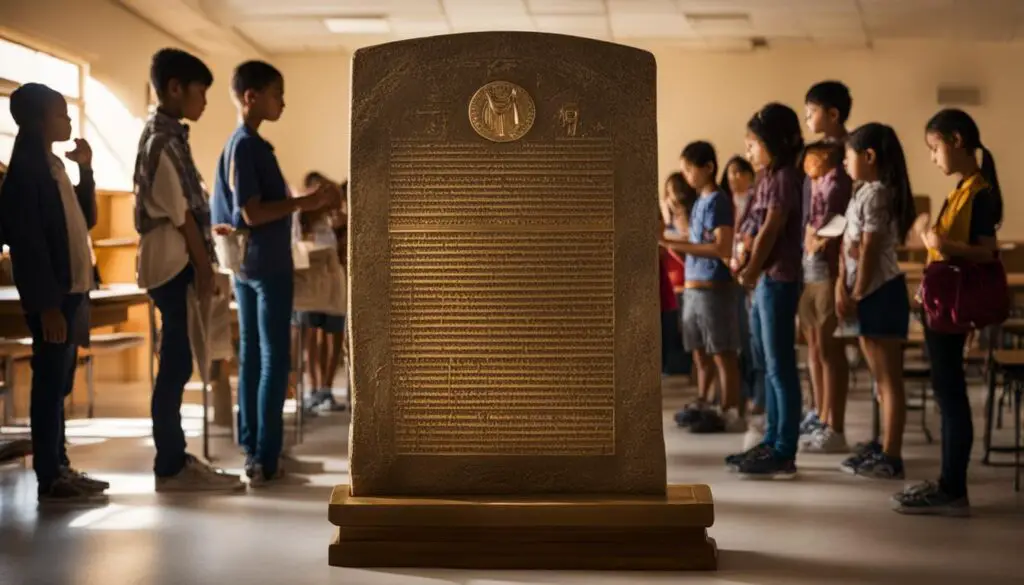
Status of Current Law on Teaching Religion
The Supreme Court has played a pivotal role in establishing tests to determine whether the teaching of religion in public schools violates the Establishment Clause of the First Amendment. Two significant tests, the Lemon Test and the Endorsement Test, have provided guidance in navigating the complex landscape of teaching religion in public schools.
The Lemon Test
The Lemon Test, derived from the landmark case Lemon v. Kurtzman, focuses on three key factors:
- Secular Purpose: The primary purpose of the religious education program must be secular, not to advance or inhibit religion.
- Non-advancement of Religion: The program should not promote or favor any specific religion.
- Lack of Excessive Entanglement: The program should avoid excessive government involvement in religious activities.
Through the Lemon Test, the Supreme Court aims to prevent the establishment of a state religion or the favoring of one religion over others in public schools.
The Endorsement Test
The Endorsement Test, originating from Lynch v. Donnelly, evaluates whether the government’s actions endorse or disapprove of religion. It examines whether a reasonable observer would perceive the government’s actions as endorsing a specific religious belief. If there is an endorsement of religion, it may be deemed unconstitutional.
Both the Lemon Test and the Endorsement Test provide guidelines for public schools to ensure that the teaching of religion remains within the boundaries of the First Amendment, respecting the rights and freedoms of all students.
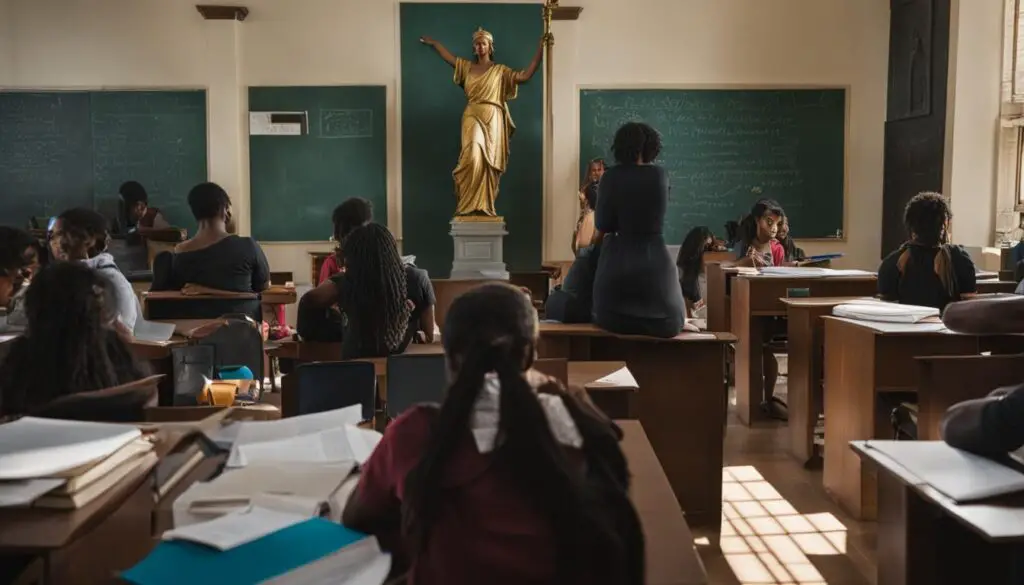
Prayer in Public Schools: Common Myths Debunked
There are various misconceptions surrounding prayer in public schools. Let’s debunk some of the most common myths and shed light on the realities of school prayer controversies.
Myth 1: Prayer Existed in Schools for 200 Years Without Complaints
“The myth that prayer in schools was widely accepted for centuries until the 1960s simply isn’t true. Controversies over religion in public schools have been ongoing since the 19th century.”
Contrary to popular belief, debates over prayer in public schools did not arise suddenly in the 1960s. In fact, concerns regarding religion in educational institutions have been present for well over a century. This myth implies that there was unanimous support for school prayer throughout American history, which is not accurate.
Myth 2: All Public Schools Had Prayer and Bible Reading
“It is a common misperception that all public schools uniformly conducted prayer and Bible reading prior to 1962. However, state-sponsored religious practices were less prevalent than believed.”
While it is true that some public schools incorporated religious practices into their daily routines before the Supreme Court rulings of the 1960s, it is a misconception to assume that all schools had mandatory prayer and Bible reading. The extent to which prayer and religious activities were promoted varied significantly across school districts and states.
Controversies and Opposition to School Prayer
The opposition to school prayer is not limited to non-religious individuals. Many religious people, including clergy, have voiced their objections to mandated and coercive forms of prayer in public schools. While some argue that prayer in schools promotes moral values and a sense of community, others believe it violates the separation of church and state and infringes upon the religious freedom of students.
One of the key concerns with school prayer is the potential for exclusion or favoritism. Schools are meant to be inclusive spaces that respect the religious beliefs of all students. Mandating or endorsing specific prayers in public schools can alienate students who come from different religious backgrounds or identify as non-religious.
“Imposing prayer in public schools goes against the principles of religious freedom and the rights of individuals to practice their own faith or to refrain from practicing any religion.”
The Supreme Court’s rulings specifically target school-sponsored prayer and Bible readings. In the landmark case of Engel v. Vitale in 1962, the Court ruled that school-sponsored prayer violates the First Amendment’s establishment clause. This clause ensures the separation of church and state and prohibits the government from endorsing or promoting a specific religion.
The Court’s decisions aim to strike a delicate balance that respects both the religious and non-religious perspectives of students. While school-sponsored prayer is prohibited, the Court recognizes the rights of individual students to engage in voluntary, non-disruptive forms of prayer. Additionally, objective instruction about religion is permissible as part of a secular program of education.
| Religious Perspective | Non-Religious Perspective |
|---|---|
| Many religious individuals argue that prayer in schools fosters a moral environment and helps students develop a sense of spirituality. | Non-religious individuals often oppose school prayer on the grounds of separation of church and state and the promotion of religious freedom for all students. |
| Religious leaders, including clergy, voice concerns over the potential discrimination and exclusion that can arise from mandated prayers in public schools. | Advocates for the separation of church and state highlight the importance of protecting the rights of students from various religious or non-religious backgrounds. |
The controversy surrounding school prayer reflects the ongoing national conversation on the role of religion in public institutions. While disagreements persist, it is essential to respect the diverse religious and non-religious beliefs of students and uphold the constitutional principles of religious freedom and the separation of church and state.
Diverse Perspectives on School Prayer and Religious Freedom
The opposition to school prayer comes from various perspectives, both religious and non-religious. Some key viewpoints include:
- The Humanist Perspective: Humanists advocate for secular education that respects the individual freedom of students and promotes critical thinking and scientific inquiry.
- The Interfaith Perspective: Interfaith organizations emphasize the importance of honoring religious diversity and creating an inclusive environment that respects the beliefs of all students.
- The Religious Liberty Perspective: Advocates for religious liberty argue that the government should not endorse or promote specific religious practices, ensuring the freedom for individuals to practice their own faith or no faith at all.
It is through these discussions and respectful exchanges of ideas that society can continue to navigate the complex issues surrounding school prayer and religious freedom.
Constitutional Rights and the Majority Rule
The constitutional system in the United States upholds equal rights for all religious and non-religious beliefs. It recognizes that the majority does not have the power to impose its views on the minority simply because of numerical superiority. One crucial aspect of preserving these rights is the First Amendment, which grants every individual the freedom to exercise their religious beliefs without coercion from public institutions.
“The First Amendment of the United States Constitution ensures that no government entity has the authority to favor one religious belief over another or force citizens to conform to a particular religious practice.”
Religious freedom is a fundamental constitutional right that allows individuals to worship and express their beliefs freely, without fear of persecution or discrimination. It encompasses the right to practice any religion or no religion at all, according to one’s conscience and personal beliefs.
The First Amendment serves as a protective shield for diverse religious and non-religious perspectives, emphasizing the importance of individual autonomy and preventing the creation of an establishment of religion by the government.
Majority Rule vs. Constitutional Protections
The principle of majority rule is deeply ingrained in the democratic process. However, it is essential to recognize that constitutional protections take precedence over the will of the majority. The fact that a significant number of individuals share a particular religious belief does not grant them the authority to impose their practices on others or infringe upon the rights of those with differing beliefs.
The First Amendment acts as a bulwark against religious tyranny, ensuring that every individual, regardless of their faith or lack thereof, is entitled to equal treatment, respect, and the freedom to follow their own religious or non-religious path.
By safeguarding the rights of religious minorities and individuals with non-religious beliefs, the First Amendment fosters an inclusive society that values diversity and respects the sanctity of personal conscience.
The Significance of Constitutional Rights
Constitutional rights, such as those protected by the First Amendment, not only preserve individual liberties but also promote a harmonious coexistence among the diverse population of the United States. These rights guarantee that everyone has the freedom to worship, express, and live according to their own beliefs, without fear of discrimination or persecution.
The assurance of constitutional rights allows citizens to engage in open dialogue, establish meaningful connections, and foster a society that embraces tolerance, understanding, and mutual respect. It encourages the exploration of different perspectives, which in turn contributes to the enrichment of society as a whole.
| Constitutional Rights | Benefits |
|---|---|
| Equal rights for all religious and non-religious beliefs | Promotes inclusivity and diversity |
| Freedom to exercise religious beliefs | Fosters personal autonomy and self-expression |
| Protection against religious oppression | Preserves individual liberties and prevents discrimination |
| Prevention of religious establishment by the government | Maintains the separation of church and state |
Conclusion
The history of prayer in schools in the United States has been a subject of ongoing debates and legal battles. Supreme Court rulings, discussions about the separation of church and state, and the protection of constitutional rights have all shaped the current state of prayer in schools.
While organized and school-sponsored prayer is prohibited in public schools, it is important to note that the First Amendment guarantees the right to private and voluntary prayer for students. This means that students are free to pray individually or in groups as long as it is not official or endorsed by the school.
Despite the absence of official prayer, public schools still play a crucial role in promoting ethical values and instilling a sense of morals among students. Educators and parents have the responsibility to nurture a supportive environment that encourages open dialogue and respect for diverse religious beliefs and non-believers.
FAQ
Is organized prayer allowed in public schools?
No, the Supreme Court has ruled that organized prayer in public schools, whether school-sponsored or initiated by students, violates the First Amendment’s Establishment Clause.
Can religion be taught in public schools?
Yes, teaching about religion as part of a secular program of education is permissible under the First Amendment. However, it must be done objectively and without endorsing any particular religion.
What Supreme Court rulings have impacted school prayer?
Several landmark Supreme Court cases have shaped school prayer policies, including Engel v. Vitale (1962) which banned school-sponsored prayer, and Santa Fe Independent School District v. Doe (2000) which prohibited even student-led, school-sponsored prayer.
What guidelines exist for school prayer?
The Department of Education has developed guidelines on school prayer to address constitutional concerns. However, these guidelines faced criticism for lacking community input and attempting to resolve complex legal debates.
Can the Ten Commandments be displayed in public schools?
The Supreme Court has issued mixed rulings on public displays of the Ten Commandments. While some displays have been deemed unconstitutional for favoring monotheistic religions, others have been allowed when conveying both religious and secular messages.
What tests does the Supreme Court use to evaluate the teaching of religion in public schools?
The Supreme Court has established tests to determine if teaching religion violates the First Amendment’s Establishment Clause. The Lemon Test examines the secular purpose, non-advancement of religion, and lack of excessive government entanglement. The Endorsement Test evaluates if the government action endorses or disapproves of religion.
Are there any common misconceptions about prayer in schools?
Yes, one common myth is that prayer existed in schools for 200 years without complaints until the 1960s. In reality, debates over religion in public schools have been ongoing since the 19th century. Another myth is that all public schools had prayer and Bible reading prior to 1962, when in fact, state-sponsored religious practices were less prevalent than believed.
Who opposes school prayer?
Opposition to school prayer is not limited to non-religious individuals. Many religious people, including clergy, object to mandated and coercive forms of prayer in public schools. The Supreme Court’s rulings specifically target school-sponsored prayer and Bible readings while preserving the rights of students to engage in voluntary, non-disruptive forms of prayer.
How does the constitutional system protect religious freedom in public schools?
The constitutional system in the United States upholds equal rights for all religious and non-religious beliefs. The First Amendment protects the rights of individuals to exercise their religious freedom without coercion from public institutions. The majority cannot impose its views on the minority simply because of numerical superiority.


